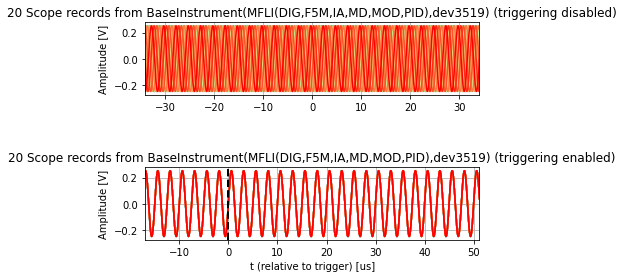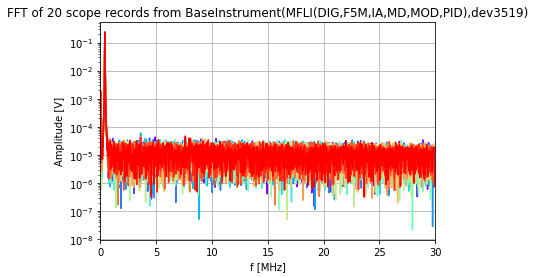Scope#
Demonstrate how to connect to a Zurich Instruments Device and obtain scope data from two scope channels using the Scope Module.
Connect to a Zurich Instruments Device via the Data Server, generate a sine wave on the signal outputs and obtain the waveform from the signal inputs using the Scope Module. The specified number of scope records are obtained from the device with and without enabling the scope’s trigger.
Requirements:
LabOne Version >= 22.02
Instruments: 1 x MF or UHF Instrument with DIG Option (HF2 does not support multi-channel recording).
[1]:
from zhinst.toolkit import Session
session = Session("localhost")
device = session.connect_device("DEVXXXX")
[2]:
SCOPE_CHANNEL = 0
SIGNAL_INPUT = 0
SIGNAL_OUTPUT = 0
Instrument configuration#
[3]:
# UHFLI: 3, HF2LI: 6, MFLI: 1
OUT_MIXER_CHANNEL = 1
with device.set_transaction():
device.sigouts[SIGNAL_OUTPUT].on(True)
device.sigouts[SIGNAL_OUTPUT].range(1.5)
device.sigouts[SIGNAL_OUTPUT].amplitudes[OUT_MIXER_CHANNEL](0.5)
device.sigouts[SIGNAL_OUTPUT].enables[OUT_MIXER_CHANNEL](True)
device.sigins[SIGNAL_INPUT].imp50(1)
device.sigins[SIGNAL_INPUT].ac(0)
OSC_INDEX = 0
device.oscs[OSC_INDEX].freq(400e3) # UHFLI: 10.0e6
device.demods[OUT_MIXER_CHANNEL].oscselect(OSC_INDEX)
Autoranging#
Execute autorange and wait for the correct state change
[4]:
if device.sigins[SIGNAL_INPUT].autorange(1, deep=True) != 0:
# The auto ranging takes some time. We do not want to continue before the
# best range is found. Therefore, we wait for state to change to 0.
# These nodes maintain value 1 until autoranging has finished.
device.sigins[SIGNAL_INPUT].autorange.wait_for_state_change(0, timeout=20)
Configuring the scope#
[5]:
SCOPE_TIME = 0
with device.set_transaction():
device.scopes[0].length(2 ** 12)
device.scopes[0].channel(1)
device.scopes[0].channels[0].bwlimit(1)
device.scopes[0].channels[0].inputselect(SIGNAL_INPUT)
device.scopes[0].time(SCOPE_TIME)
device.scopes[0].single(False)
device.scopes[0].trigenable(False)
device.scopes[0].trigholdoff(0.050)
device.scopes[0].segments.enable(False)
Initializing the scope module#
[6]:
MIN_NUMBER_OF_RECORDS = 20
scope_module = session.modules.scope
scope_module.mode(1)
scope_module.averager.weight(1)
scope_module.historylength(20)
scope_module.fft.window(0)
Subscribing to the scope node data#
[7]:
wave_node = device.scopes[0].wave
scope_module.subscribe(wave_node)
Obtain scope records from the device using an instance of the Scope Module.#
Helper functions for getting the scope records.
[8]:
import time
def check_scope_record_flags(scope_records, num_records):
"""
Loop over all records and print a warning to the console if an error bit in
flags has been set.
"""
num_records = len(scope_records)
for index, record in enumerate(scope_records):
record_idx = f"{index}/{num_records}"
record_flags = record[0]["flags"]
if record_flags & 1:
print(f"Warning: Scope record {record_idx} flag indicates dataloss.")
if record_flags & 2:
print(f"Warning: Scope record {record_idx} indicates missed trigger.")
if record_flags & 4:
print(f"Warning: Scope record {record_idx} indicates transfer failure" \
"(corrupt data).")
totalsamples = record[0]["totalsamples"]
for wave in record[0]["wave"]:
# Check that the wave in each scope channel contains
# the expected number of samples.
assert (
len(wave) == totalsamples
), f"Scope record {index}/{num_records} size does not match totalsamples."
def get_scope_records(scope_module, num_records: int):
"""Obtain scope records from the device using an instance of the Scope Module."""
scope_module.execute()
device.scopes[0].enable(True)
session.sync()
start = time.time()
timeout = 30 # [s]
records = 0
progress = 0
# Wait until the Scope Module has received and processed
# the desired number of records.
while (records < num_records) or (progress < 1.0):
time.sleep(0.5)
records = scope_module.records()
progress = scope_module.progress()
print(
f"Scope module has acquired {records} records (requested {num_records}). "
f"Progress of current segment {100.0 * progress}%.",
end="\r",
)
if (time.time() - start) > timeout:
# Break out of the loop if for some reason we're no longer receiving
# scope data from thedevice
print(
f"\nScope Module did not return {num_records} records after {timeout} s - \
forcing stop."
)
break
device.scopes[0].enable(False)
# Read out the scope data from the module.
data = scope_module.read()[wave_node]
# Stop the module; to use it again we need to call execute().
scope_module.finish()
check_scope_record_flags(data, num_records)
return data
Obtain data with triggering disabled#
[9]:
data_no_trig = get_scope_records(scope_module, MIN_NUMBER_OF_RECORDS)
Scope module has acquired 20 records (requested 20). Progress of current segment 100.0%.
Obtain data with triggering enabled#
[10]:
with device.set_transaction():
device.scopes[0].trigenable(True)
device.scopes[0].trigchannel(SIGNAL_INPUT)
device.scopes[0].trigrising(1)
device.scopes[0].trigfalling(0)
device.scopes[0].triglevel(0.0)
device.scopes[0].trighysteresis.mode(1)
device.scopes[0].trighysteresis.relative(0.1)
device.scopes[0].trigholdoffmode(0)
device.scopes[0].trigholdoff(0.050)
device.scopes[0].trigreference(0.25)
device.scopes[0].trigdelay(0.0)
device.scopes[0].triggate.enable(0)
[11]:
data_with_trig = get_scope_records(scope_module, MIN_NUMBER_OF_RECORDS)
Scope module has acquired 29 records (requested 20). Progress of current segment 100.0%.
Obtain and perform an FFT on the data#
[12]:
scope_module.mode(3)
scope_module.fft.window(1) # Hann window function
data_fft = get_scope_records(scope_module, MIN_NUMBER_OF_RECORDS)
Scope module has acquired 29 records (requested 20). Progress of current segment 100.0%.
Plot the results#
[13]:
import numpy as np
import matplotlib.pyplot as plt
from matplotlib import cm
clockbase = device.clockbase()
Plot time domain results#
[14]:
def plot_time_domain(axis, scope_records, scope_input_channel):
colors = cm.rainbow(np.linspace(0, 1, len(scope_records)))
def to_timestamp(record):
totalsamples = record[0]["totalsamples"]
dt = record[0]["dt"]
timestamp = record[0]["timestamp"]
triggertimestamp = record[0]["triggertimestamp"]
t = np.arange(-totalsamples, 0) * dt + (
timestamp - triggertimestamp
) / float(clockbase)
return 1e6 * t
for index, record in enumerate(scope_records):
wave = record[0]["wave"][scope_input_channel, :]
ts = to_timestamp(record)
axis.plot(ts, wave, color=colors[index])
plt.draw()
axis.grid(True)
axis.set_ylabel("Amplitude [V]")
axis.autoscale(enable=True, axis="x", tight=True)
_, (ax1, ax2) = plt.subplots(2)
# Plot the scope data with triggering disabled.
plot_time_domain(ax1, data_no_trig, SCOPE_CHANNEL)
ax1.set_title(f"{len(data_no_trig)} Scope records from {device} (triggering disabled)")
plt.subplots_adjust(hspace = 1)
# Plot the scope data with triggering enabled.
plot_time_domain(ax2, data_with_trig, SCOPE_CHANNEL)
ax2.axvline(0.0, linewidth=2, linestyle="--", color="k", label="Trigger time")
ax2.set_title(f"{len(data_with_trig)} Scope records from {device} (triggering enabled)")
ax2.set_xlabel("t (relative to trigger) [us]")
plt.show()

Plot FFT results#
[15]:
def to_frequency(record, scope_time):
totalsamples = record[0]["totalsamples"]
scope_rate = clockbase / 2 ** scope_time
return np.linspace(0, scope_rate / 2, totalsamples) / 1e6
# Plot the FFT of the scope data.
_, axis = plt.subplots()
axis.set_title(f"FFT of {len(data_fft)} scope records from {device}")
axis.set_xlabel("f [MHz]")
colors = cm.rainbow(np.linspace(0, 1, len(data_fft)))
for index, record in enumerate(data_fft):
wave = record[0]["wave"][SCOPE_CHANNEL, :]
freq = to_frequency(record, SCOPE_TIME)
axis.semilogy(freq, wave, color=colors[index])
axis.set_title(f"FFT of {len(data_fft)} scope records from {device}")
axis.set_xlabel("f [MHz]")
plt.draw()
axis.grid(True)
axis.set_ylabel("Amplitude [V]")
axis.autoscale(enable=True, axis="x", tight=True)
plt.show()

[ ]: